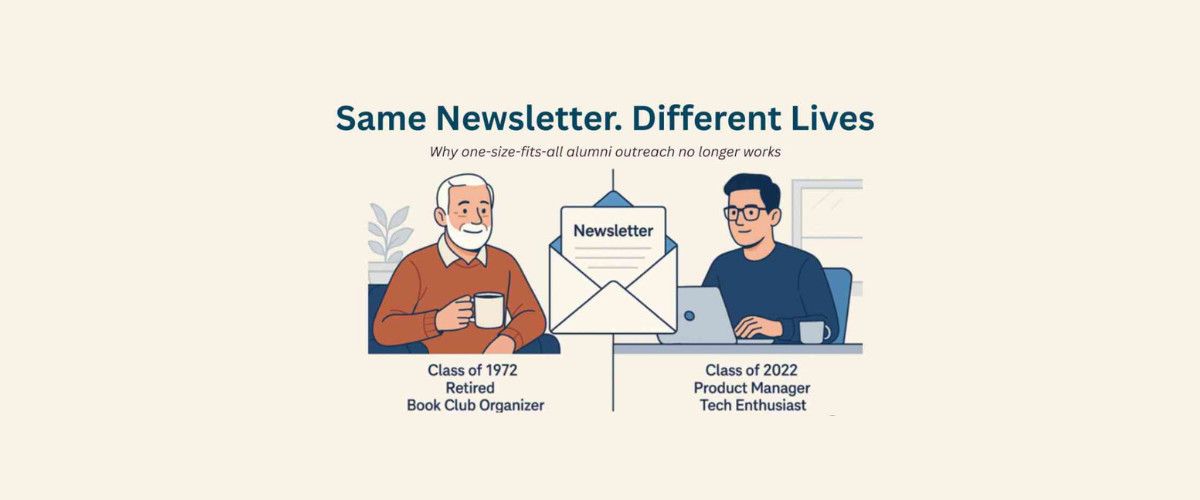Think about how you’d feel if your alma mater reached out to you in a way that truly resonated with who you are—something more than just a generic email. Personalized alumni engagement does just that! It’s about creating real, human connections, making every alumni feel valued and involved in a way that goes beyond the usual. How would you like to be engaged with? Let’s make that happen!
What If Alumni Engagement Wasn’t One-Size-Fits-All?
Why relevance is the new currency of connection—and how institutions are turning data into stronger alumni relationships.
There’s a disconnect quietly unfolding across alumni relations teams around the world.
On one hand, the numbers tell a promising story:
Over 70% of alumni are open to reconnecting with their alma mater.
But the reality?
Only 12–15% actually engage—with emails, events, mentorships, fundraising initiatives, or institutional updates.
This is not due to disinterest or a lack of affinity. In fact, alumni often speak fondly of their college years. They feel a connection, a sense of belonging, a willingness to contribute.
But what stops them is something subtler, and more systemic: irrelevance.But what stops them is something subtler, and more systemic: irrelevance.

The High Cost of Irrelevant Outreach
Here’s the scenario we see far too often: A retired academic in their seventies receives the same newsletter as a recent engineering graduate working for a startup. A marketing executive in Dubai and a social worker in Manchester are both invited to the same fundraising dinner in New York. An open call for mentors goes out to all alumni, regardless of field, availability, or interest.
The intent is inclusive. But the outcome? Underwhelming.
When engagement strategies don’t reflect where alumni are in life—or what they care about—responses decline. Not because they’re disengaged, but because they don’t see themselves in the message.
And when they tune out, institutions lose more than attention. They lose potential:
- The keynote speaker who might have inspired your graduating class
- The donor ready to support scholarships, had the appeal aligned with their values
- The alumnus willing to mentor—if only they’d been asked directly
- The professional happy to host a regional meetup, had they known others were nearby
All of this potential slips away. Quietly. Invisibly. And cumulatively, it costs institutions thousands of meaningful connections.
The Shift: From Mass Messaging to Smart Personalization
What separates institutions seeing high-impact alumni engagement from those struggling with low response rates?
It’s not more staff,budget or content. It’s how they’re using the data they already have.
Alumni engagement is no longer about volume. It’s about precision. The ability to reach the right alumni, with the right message, at the right time.
And institutions that are doing this well are seeing measurable returns:
- 3.2x higher campaign responses
- 40% increase in event attendance
- Greater two-way engagement through surveys, feedback loops, and community channels
- Stronger sentiment and affinity over time
They’re building not just communications—but conversations.
How the Best Are Doing It
Smart institutions are using segmentation and personalization in strategic, intentional ways. Here are a few approaches that are working:
1. Segment by Graduation Cohorts
What interests a 2023 graduate is worlds apart from a 1983 alumnus. Communications that reflect generational priorities—career support, networking, giving back, or nostalgia—are far more likely to resonate.
2. Personalize by Location
Global alumni networks are diverse. A workshop relevant to professionals in Singapore won’t appeal to alumni in San Francisco. Smart systems can deliver location-relevant content, events, and opportunities—without burdening your team.
3. Target by Industry or Role
Finance professionals in London may respond to thought leadership events or round table panels. Educators may be drawn to mentoring opportunities. Entrepreneurs may want peer networking. The more aligned the content, the greater the engagement.
4. Engage Based on Past Behavior
If an alumnus attended a virtual panel last year or downloaded a career guide, that’s a clear signal of interest. Following up with similar offerings increases both the likelihood of re-engagement and the perceived value of your outreach.
Relevance Isn’t About Technology—It’s About Mindset
The good news is, this level of personalization doesn’t require overhauling systems or doubling headcount. In most cases, the data exists. The platforms are in place. What’s often missing is the strategy—and the shift in mindset from “more messages” to “more meaningful messages.”
Think of it this way:
A blanket message sent to 100,000 alumni with a 0.8% click-through rate? That’s 800 clicks.
Now imagine a targeted campaign sent to 15,000 industry-aligned alumni with a 5% response rate? That’s 750—almost the same impact, but with a fifth of the volume.
Not only is it more efficient, but it also builds trust. Alumni begin to see communications as valuable rather than clutter. They look forward to hearing from you—not unsubscribing.
Re imagining Engagement: From Outreach to Ownership
Engagement isn’t a one-way street. The goal isn’t simply to inform—it’s to involve.
When alumni receive personalized opportunities—matched to their values, skills, and location—they don’t just respond.They participate with purpose, champion your mission, and become powerful advocates.
This is the new frontier of alumni relations. Not transactional. Not administrative. But relational. Strategic. Human.
Key Takeaways for Institutions Ready to Evolve
If you’re ready to break away from the one-size-fits-all model, here are three places to start:
- Audit Your Communications: Identify where you’re sending the same message to vastly different audiences. This is your opportunity zone.
- Invest in Segmentation: Even simple filters—by location, graduation year, or program—can transform the relevance of your outreach.
- Track What Resonates: Let data guide your strategy. Monitor engagement rates, responses, and feedback. Let alumni behavior show you what matters.
Final Thought: Relevance Builds Relationships
Alumni don’t disengage because they’ve forgotten their alma mater. They disengage when their alma mater forgets them.
So the question isn’t, “How can we reach more alumni?” It’s, “How can we make every interaction feel like it was meant for them?”
The answer doesn’t lie in sending more. It lies in sending better. More meaningful. More relevant. Truly personal
And as institutions make this shift—from mass outreach to intentional engagement—they’re not just increasing participation. They’re building something far more valuable: lasting alumni relationships that grow stronger over time.





 March 10, 2025
March 10, 2025
